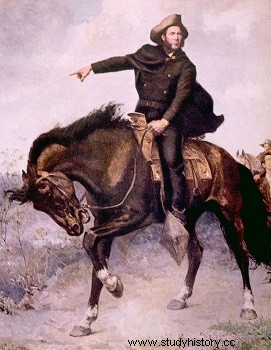
Samuel Houston (March 2, 1793 – July 26, 1863) was an American statesman, politician, and military man.
Born in Virginia, he is one of the main figures in the history of Texas. He was successively President of the Republic of Texas, United States Senator after Texas joined the Union, and finally Governor. Although a slave owner and opponent of abolitionism, his Unionist beliefs led him to refuse to take the oath of loyalty to the Confederacy when Texas seceded from the Union, leading him to resign as governor. Not to be ashamed of his Texan affiliation, he nevertheless refused the Union's offer of a military command to put down the rebellion and retired to Huntsville, Texas, where he died before the end of the war.
Early in his life, he emigrated to Tennessee, spent time in the Cherokee Nation (where he was adopted and married), did his military service in the War of 1812, and was successfully involved in Tennessee politics. . Until today, Houston is the only person in American history to have served as governor in two different states, Tennessee and Texas. A duel with a member of Congress followed by a trial led him to emigrate to Texas, then Mexican territory, where he quickly became a leader of the Texas revolution.
He was in favor of joining the United States. The city of Houston bears his name from this period. His reputation and his name survive him with a memorial museum, a US Army base, Fort Sam Houston, a historical park, a university, Sam Houston State University and the largest statue erected to an American hero.
Sam Houston left his wife Diana Rodgers to settle in Mexican Texas in December 1832. He attended the 1833 Convention as a representative of Nacogdoches and supported William Harris Wharton and his brother, two radical supporters of Texas independence vis -with respect to Mexico. He also took part in the Consultation of 1835 and was appointed general and then commander of the Texas army during the Texas Revolutionary War. After the declaration of independence on March 2, 1836, he joined his army of volunteers at Gonzales, but had to retreat before the troops of Mexican general and dictator Antonio López de Santa Anna, who massacred the defenders of the Alamo fort in San Antonio on March 6, 1836. However, he won the Battle of San Jacinto on April 21, 1836, in which Santa Anna was captured. Sam Houston attended the negotiations before returning to the United States for treatment.
Taking advantage of his popularity, Sam Houston was twice elected President of the Republic of Texas from October 22, 1836 to December 10, 1838, then from December 12, 1841 to December 9, 1844. On December 20, 1837, he presided over the convention of Freemasons which founded the Grand Lodge of the Republic of Texas.
He defeated the Cordova Rebellion in 1838. During his second term, he sought to make peace with the Native Americans and to avoid war with Mexico after the two invasions of 1842. In August 1836 the brothers J.K. Allen and A.C. Allen named their new colony Houston. The city was the capital of Texas until President Mirabeau Bonaparte Lamar moved it to Austin on January 14, 1839. Between his two terms as president, Sam Houston was a member of the Texas House of Representatives for San Augustine. He was very critical of Mirabeau B. Lamar and campaigned to preserve the independence of Texas and its expansion westward.
